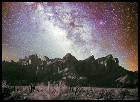| KnoxNews |
| To print this page, select File then Print from your browser |
| URL: http://www.knoxnews.com/kns/news_columnists/article/0,1406,KNS_359_3707817,00.html |
 RICHARD PAYNE / ARIZONA ASTROPHOTOGRAPHY The Milky Way illuminates the night sky above the Kofa Mountains of Arizona. |
Light pollution drowning out stars in nighttime sky
By DOUGLAS HULLANDER
April 18, 2005
For millions of people around the globe, nothing moves the psyche toward
a feeling of oneness with the universe like the sight of the Milky Way
-- that swath of stars and haze that on warm summer nights spans the sky
fromhorizon to horizon. However, that tie to our primordial past is being slowly severed.
Eighty percent of the world's population can no longer gaze upward and expect to see the majestic spectacle of a starry night.
The blame rests with light pollution, the inadvertent
illumination of the atmosphere from a variety of artificial sources --
street lights, outdoor advertising, automobiles, homes, schools,
airports, etc.
Millions of kilowatts, billions of bulbs and tubes, are all
sending light energy skyward to strike tiny particles floating in the
air.
Here's why it matters, what's happening in the atmosphere and what people can do to combat light pollution.
It's no wonder that gazing to the heavens has for millennia been
so awe-inspiring, for it was from this dust and gas of the Milky Way
that the Earth and its eventual cargo of life were created eons ago.
The molecules that comprise the Earth, our bodies and our minds once
floated in that seething interstellar potpourri.
So in a very real sense, the Milky Way is our birthplace, a celestial connection to our past, a link to our earliest origins.
But only those living many miles from population centers are
able to behold the wonders of heavens. For unfortunate city dwellers,
most of the constellations, the planet Saturn and a host of medium
magnitude stars have disappeared, swallowed up by the artificial glow
of nighttime.
Take a look at http://antwrp.gsfc.nasa.gov/apod/ap001127.html to see how population centers radiate light into space at night.
Microscopic bits of matter reflect much of the light right back.
The result: An atmosphere that glows with a radiance easily washes out
the light from not only the Milky Way, but the light from all but the
brightest stars and planets as well.
On a good night in New York City, for example, no more than a
half-dozen stars can be seen. Without light pollution, about 2,500
would be visible.
And city folk can forget about observing the occasional meteor shower. They, too, are history.
Being deprived of the stars, planets and meteors is an enormous
loss. But to lose touch with the majesty of Milky Way is an
incalculable tragedy.
Esthetics aside, the disappearance of the nighttime sky is
bound to leave an indelible mark on this as well as future generations.
The ramifications are likely to be diverse and deeply profound --
affecting education, social interactions and perhaps even human
psychology.
For example, are kids who never see the stars less likely to
become scientists? Do frustrated stargazers lose perspective about our
place in the cosmos? What if humans have an inborn, genetically
programmed need to maintain visual contact with Milky Way?
Dr. Tony Mezzacappa, an astrophysicist at Oak Ridge National
Laboratory, worries that the disappearance of the Milky Way deprives
observers of a unique perspective.
"If one is able to see only a dozen or so stars, all rather
evenly distributed across the sky," Mezzacappa says, "if that wide
expanse of hazy starlight we call the Milky Way is invisible, then how
can the casual observer possibly gain an intuitive feel for the Earth
as a part of this greater whole?"
Dr. David Fields, director of the Tamke-Allen Observatory near
Harriman wonders: "Do we need the vastness of nighttime space to
recognize the fragility and beauty of our Earth? And do we need to see
nearby stars that might have planetary systems in order to be reminded
that we may not be alone in the universe?"
As serious as this problem is, there's no need for despair. A
way to keep the Milky Way and the rest of the heavens from being
bleached into oblivion exists.
The solution is as simple as designing outdoor light fixtures
so that they don't direct their light upward. And, in many cases, the
intensity of outdoor lighting could be significantly reduced without
comprising safety or function.
If redesigned outdoor lighting is more efficient, billions of dollars and energy resources also can be saved.
To learn more about techniques to combat light pollution and
about cities that use redirected lighting, visit the Web site of the
International Dark Skies Association at www.darksky.org. There are perhaps only a handful of experiences in life that seem to resonate with our inner being.
There are perhaps only a handful of experiences in life that seem to resonate with our inner being.
Copyright 2005, KnoxNews. All Rights Reserved.